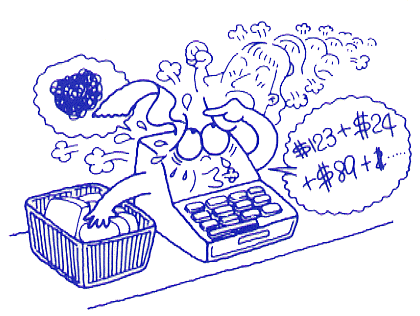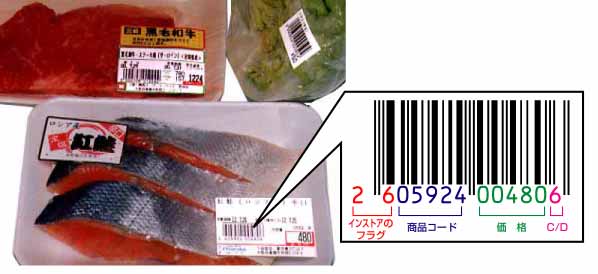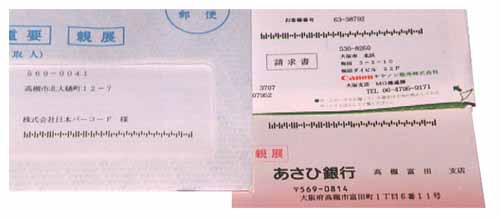
We try to avoid using technical terms, but when they appear, please click the hyperlinked word (in blue) to jump to our barcode dictionary.
Without typing on the keyboard, only by scanning the bars, numbers and alphabets are directly entered into the computer.
Using combination of thick bars and thin bars (binary level), or combination of the widths of black bars and white gaps (spaces) between the bars (multi-level), like a cipher text, the data is submitted through the decoding scanner.
(See A Variety of Barcode for those combinations)
And if we misread the barcode because of dirt or lack of bars, almost every barcodes has checkdigit which prevent us from misreading, and the misread data won't be entered.
So, going to the length of saying, even the foreigners or the children who don't know reading can enter by means of barcode.
Moreover, barcodes are read in ultra high-speed which cannot be compared
to handwritten slips or price tags.
(eg. POS register can read 5000 barcodes per second).
On the other side, our eyes and handtyping are incomparably slower than barcode.
There are various way of automatic recognitions.
For example,
These days, 2-dimentional codes which can house big data is touted as a rising star. But because of patent licenses and low penetration of related devices, The 2D codes haven't generally popularized yet.
In this respect, the barcode is available to everyone, its patents are licence-free in a long history, with abondance of related devices, and furthermore, it is the world-wide standard. So we can say the barcode is one of the most popular method of automatic recognition.
In the United States -- it's a huge country where they take a car or airplane to visit the neighbor -- people go shopping once a week and stock foods in the huge refrigerator. To meet people's demand, large scale retailers such as supermarkets have well-developed.

To dissolve this long queue, many solutions are thought. For example, putting metal whose weight accords with the price, weigh the total weight to sum up the price. But they were off from practical use.
In 1967 --- practical application of the computer had just started -- The Kroger Company, a major large scale chain retailer, was trying to resolve these situations and developed the barcode-oriented entry system -- attach a barcode to each product and enter the product data automatically into computer -- and finally put it into practical use. That was the beginning of the barcode of products.
But to spread the barcode all over the United States, they had to make a nationally-standardized rule to assign the number to each product.
That's where UPC (Universal Product Code) came in, in 1973, established with the help of American Food Chain Association, etc.
In Europe, where there had been the same problem as that in America, aiming at this success of UPC, they established in 1977 EAN, the common product code of European countries: United Kingdom, France, Germany, etc. Japan joined them in 1978.
The member countries of EAN are listed in "flag" page. Among them, there are some developing country where large scale retailers haven't appeared yet; but even in these countries, they need the barcode when they want to export thier products.
Universal Product Code consists of
Then, to enable this number to be read by the computer, this code system are applied to barcode: UPC (US and Canada) and EAN (Europe and all over the world).
The name varies from country to country; it is called for example JAN symbol in Japan, KAN symbol in South Korea, etc.

At first, marchandises packed in carton cases come in.
On these carton cases,
Standard Logistics Symbol (ITF) barcodes are
printed and they indicate the item codes and quantity of contents.
These informations -- the time, type of product and quantity, etc. -- are scanned and they are entered automatically into the computer.
At the same time, when the shipper and the cost price are entered, the payment information -- what time, how much we must pay to the shipper, etc. -- is also registered into the computer.
Next, enter the selling price of this product. People often ask us "is there any price information coded in barcode ?", but the barcode has only the proper and unique code of the product.
The price of the product which has the same code may change according to the stores who sell it. So the price cannot be coded before; it's the store who decides the price according to its profit.
The store can set the price and discounting periods flexibly; only the store has to do is enter the periods -- bargain days, service hours, etc. --- into the computer.
This type of product which circulates widely and its price is looked up on the computer at the cash register is called "PLU" product.
Now, when the customer does some shopping and passes through the checkout stand, the computer tells the price of goods to the register, registers the sales at the same time, and moreover, the decrement of stock is automatically registered.
Computer may make statistical inferences, on various movements of the sales, from the analysis of these data. For example, it sells well after paydays, in the evening of rainy days, etc.
When a product sells well and its stock decreases, the product needs to be replenished. Then automatically the computer orders the replenishment to avoid out-of-stack.

Because the weight of each product differs, the price is calculated with the unit price per 100 grams; The weighing machine calculates the price of each package in accordance with its weight, prints a barcode label that meets the name and weight of the product and attach it to the product.
Instore marking, or Instore marked barcode is the barcode passable only in the store, or within the specific logistics route.
To the products that each one has a different price, or to that the store manufactures such as a prepared dish, the store attaches a barcode to the product including its price.
The products like this are called "NON-PLU" products because their prices aren't asked to the computer.
The movement of these NON-PLU goods' sales are registrated in the computer. By analysing this data, we can exercise ingenuity in the sales. For example, what's the best interval to prevent raw fish from drying, from what time sushi must be served, etc.
The barcode attached to the products performs in every way from purchacing strategies to selling strategies, from sales control to purchace control.
During this flow, the barcode printed on carton box case (it is usually ITF (Standard Logistics Symbol, CASECODE)) is scanned at each moment of logistics.
By attaching another barcode for indicating item codes, spec codes, color codes, etc., we can use the barcode in every phase, from material to product, not only in inventory control and arrival/shipment control, but also in production control and material purchasing control, etc.
We've explained briefly several well-known barcodes attached to merchandises. Now we'll introduce some other examples of barcode's performances behind the scenes.
![[bank book]](../images/bank.jpg) Do you have a bank deposit book ?
When you make a withdrawal at ATM in the bank, if you insert the incorrect page into the machine,
machine would reject it impolitely and say "open the correct page"
-- impolite not only because it must be the bank clerk who turns pages to and opens the correct page,
but also because this machine let the customer substitute the bank clerks' job --
the secret with which the machine distinguish the wrong page is the barcode printed on the margin.
Did you noticed it ?
Do you have a bank deposit book ?
When you make a withdrawal at ATM in the bank, if you insert the incorrect page into the machine,
machine would reject it impolitely and say "open the correct page"
-- impolite not only because it must be the bank clerk who turns pages to and opens the correct page,
but also because this machine let the customer substitute the bank clerks' job --
the secret with which the machine distinguish the wrong page is the barcode printed on the margin.
Did you noticed it ?

 There are many and various barcodes, visible or invisible, everywhere around you and your life.
There are many and various barcodes, visible or invisible, everywhere around you and your life.For example, see the photo on the left side. This is an ordinary photo film, and it has three barcodes: starting from the left, one as a product, one which enables camera an automatic recognition of the film sensitivity, one for management of image development.
These uses of barcode that we've just mentionned above are merely a tip of the iceberg.
Let's look for barcodes in your backyard ! You'll see the barcodes playing an active role, in unexpected places.